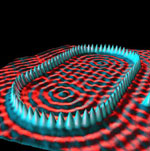Introduction
Success in self-assembly is intimately linked to how we try to experimentally achieve our goals. This module is designed to show the methods that engineers and scientists employ to design gas-phase equipment capable of producing nanoscale materials. To get there we will need considerable excursions into the gas laws as well as application of our knowledge of chemical bonding, both from the previous module on Scaling Laws.
We have seen some examples of self-assembly in condensed phases and there are several other examples in the module on Condensed Phase Self-Assembly. For a mobile condensed phase, such as a liquid, self-assembling reactions are mediated by chemical forces such as hydrogen bonding and van der Waals potentials. Such bonding is inherently weak compared to normal chemical bonds and high temperatures will dissociate them.
The situation is quite different for reactions that are mediated from the gas phase; the usual situation is dominated by the fact we need high temperatures to vaporize potentially reactive species. Furthermore, the reactive species are usually condensed onto a surface in order to recover desired products. Finally, we often need relatively high temperatures to ensure the condensed structures re-arrange into the desired final molecular configuration. Hydrogen bonding and van der Waals bonding are so weak that they are usually ineffective at the temperature of most gas phase reactions.
Once gaseous molecules are induced to condense on a solid surface, there are two possible results that we might want to occur that are diametrically opposite to each other. These are: 1) to achieve thermodynamic equilibrium of deposited species or 2) to freeze non-equilibrium structures of these deposited species.
If you are skilled, and also lucky, Nature sometimes allows the condensed molecules be deposited in exactly the form that is desired. For example, we might want to deposit vaporized carbon species as diamond; since the thermodynamically stable configuration for hot carbon is just plain graphite we want to “lock in” the diamond phase even though it is theoretically unstable at deposition conditions. In other cases, the condensed molecules might be required to be defect free and in perfect crystalline harmony (as required for many electronic purposes). Quite often, internal defects have to be “annealed” out of the deposited solid material by taking advantage of the mobility of atoms to move on hot surfaces.
For many solid high melting materials, atomic surface mobility is coincident with the so-called “Tammann” temperature, which is related to “surface diffusion”. In consequence, surface diffusion has a major influence on the defects in a thin layer of a deposited solid material. The Tammann temperature is a phenomenon based on considerable experimental evidence; surface-mediated mobility of many materials occurs at a temperature variously estimated for different classes of materials that is from 30% to 75% of the material’s absolute (i.e., kelvins) melting point (50% is a reasonable first approximation). Thus a good rule of thumb is that we can anneal defects from deposits by maintaining them at a temperature of about 50% of their absolute melting point (assuming there is a melting point for the material in question). Under this circumstance, the temperatures required are such that neither H-bonds nor van der Waals are likely to contribute to bonding.

